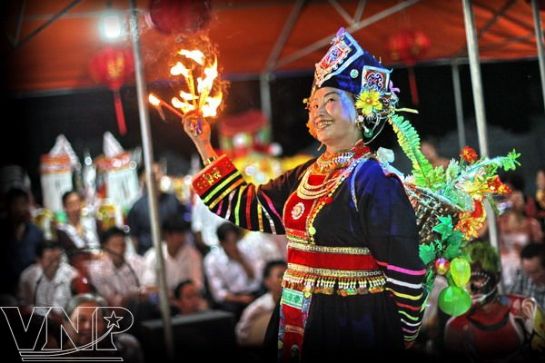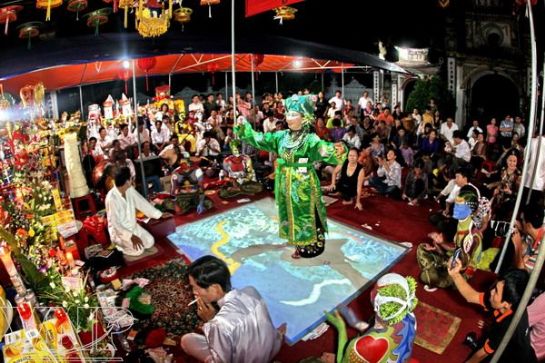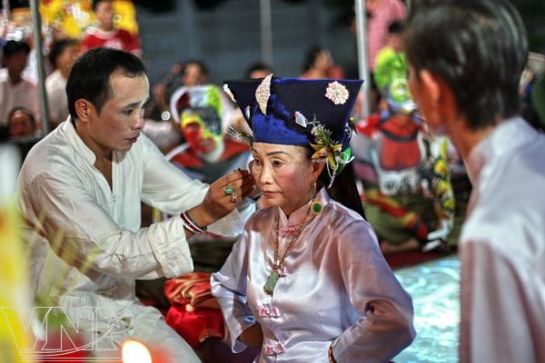|
The
ritual to worship Mother, or the Mother Goddess Religion, is one of the
main religions in Vietnam which originated from the thousand-year-old age
of matriarchy. From the 16th century, based on the ritual to
worship the Goddesses, it developed into the worshipping of the Three (or
Four) Mother Goddesses with Mother Goddess Lieu Hanh being in the
ancestral tablet. Hau dong, a spirit possession ritual of the
Mother Goddess religion, is a folk religious performance that holds both
spiritual and folk artistic meanings.
|

Sincerely offering
incense sticks before a Hau dong ritual.
|
|

A session performed
by Hau dong ritual’s spirit medium.
|
|

A Hau dong ritual held in Lanh Giang
Temple in Duy Tien District, Ha Nam Province.
|
|

The female spirit
medium is covered with a red scarf to wait for the spirit to
incarnate into.
|
|

Preparing costumes
for the spirit medium.
|
|

Preparing costumes
for the spirit medium.
|
|

People in Moc Nam Commune, Duy Tien District,
Ha Nam Province is interested
in participating in a Hau
dong ritual held in Lanh Giang
Temple.
| nbsp;
Hau
dong
is a combined ritual with various folk artistic values in terms of
literature, music, dancing, fine arts, performing art and folk festival.
The performers, called spirit mediums, are thought to be able to contact
directly with the spirits, while the ceremony attendants (the audience)
hope to have contact with the spirits to ask for their blessing.
Hau
dong
is often held in temples or palaces where there is always a solemn
religious space for worshipping and making offerings to the holy beings.
The ritual of mother worship is symbolized through the statues, folk
paintings, decorations and costumes in five colours representing five
basic elements (metal, wood, water, fire and earth according to Eastern
philosophy). Hau dong is performed on a stage in front of the
Mother Goddess' altar, which is called a spiritual stage. The head of a
Hau dong ritual can be either male or female and is believed to
have a spirit within who performs on the stage covered with a mat and is
helped by two assistants in charge of changing the medium's costumes to be
appropriate to each session. A band of musicians sit by the stage playing
flutes, drums and a two-stringed zither and are accompanied by two or
three singers who sing when the spirit crosses over to the medium. For
each Hau dong performance there may be several spirits who, one
after another, incarnate into the medium to dance and distribute offerings
to the audience. When the medium gets into a trance, a session begins. In
general, there are about 36 sessions for one Hau dong, each representing a spirit,
a goddess, a mandarin or a sacred object.
The
dances in a Hau dong performance comprise various
forms of the dancing art. In each session the dances represent the
characteristics of the spirit. If he is a general, the dances will be
martial arts moves – quick and strong – with military weapons and flags,
and if she is a mountainous goddess, normally an ethnic woman, the medium
will dance with fans or just bare hands in ethnic musical tunes. The fans
are made with leather and in colours of white, green, red or yellow, each
suited to the palace decoration of each goddess. A session for a prince
will have dances with a lance, a cudgel or a bow and arrows, while for a
princess' session, the dances are very charming when the medium wears
beautiful costumes, dancing with fans and flowers, pretending to embroider
or row a boat... In imitating dances, the audience will see the medium
mimic riding a horse, rowing a boat, or carrying loaded baskets. Dancing
props are a sword, fans, oars, scarves, nbsp;nbsp;flags, etc.
A
Hau dong stage can be as small as the size of a mat, hence
conventional and stylized forms are used in dancing. All body movements
are performed in such a skilful way that the audience will feel that the
spirit is on the stage in front of them, in the body of the medium. In
addition to the body performance, the literary value of the Hau
dong is reflected through the songs, dances,
tales and verses rich in philosophy, music and humanity.
Story: Vinh
Hung
Photos: Vu
Hieunbsp;nbsp;
nbsp; |